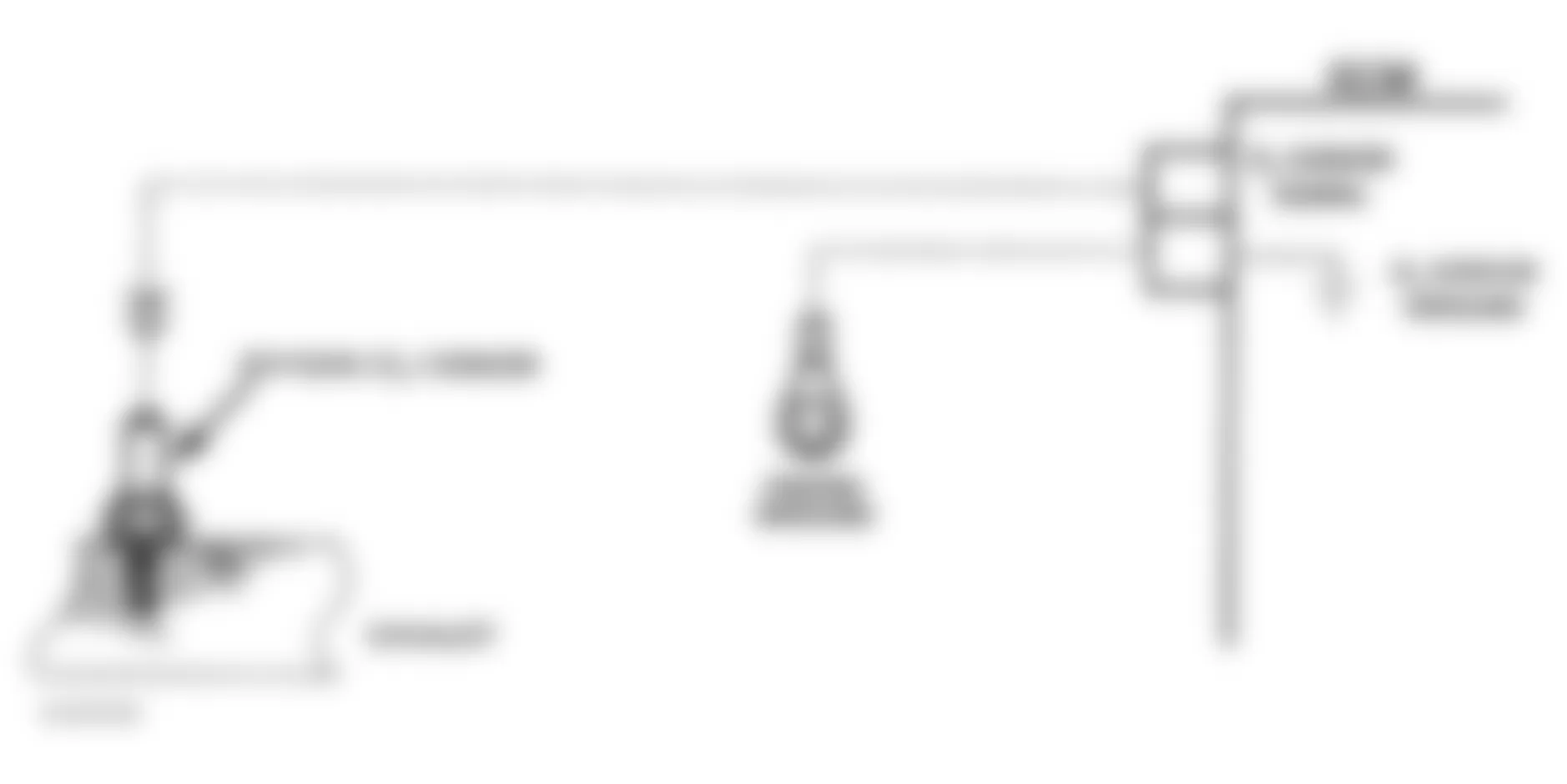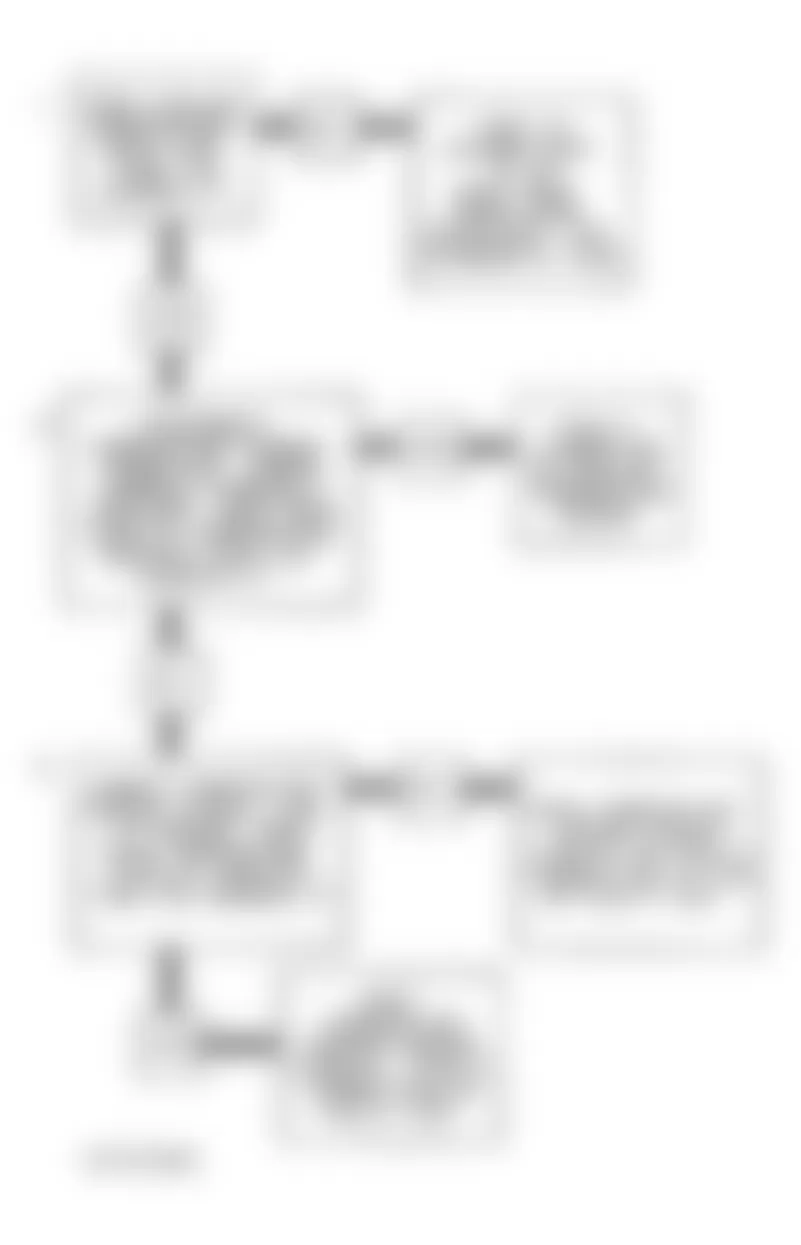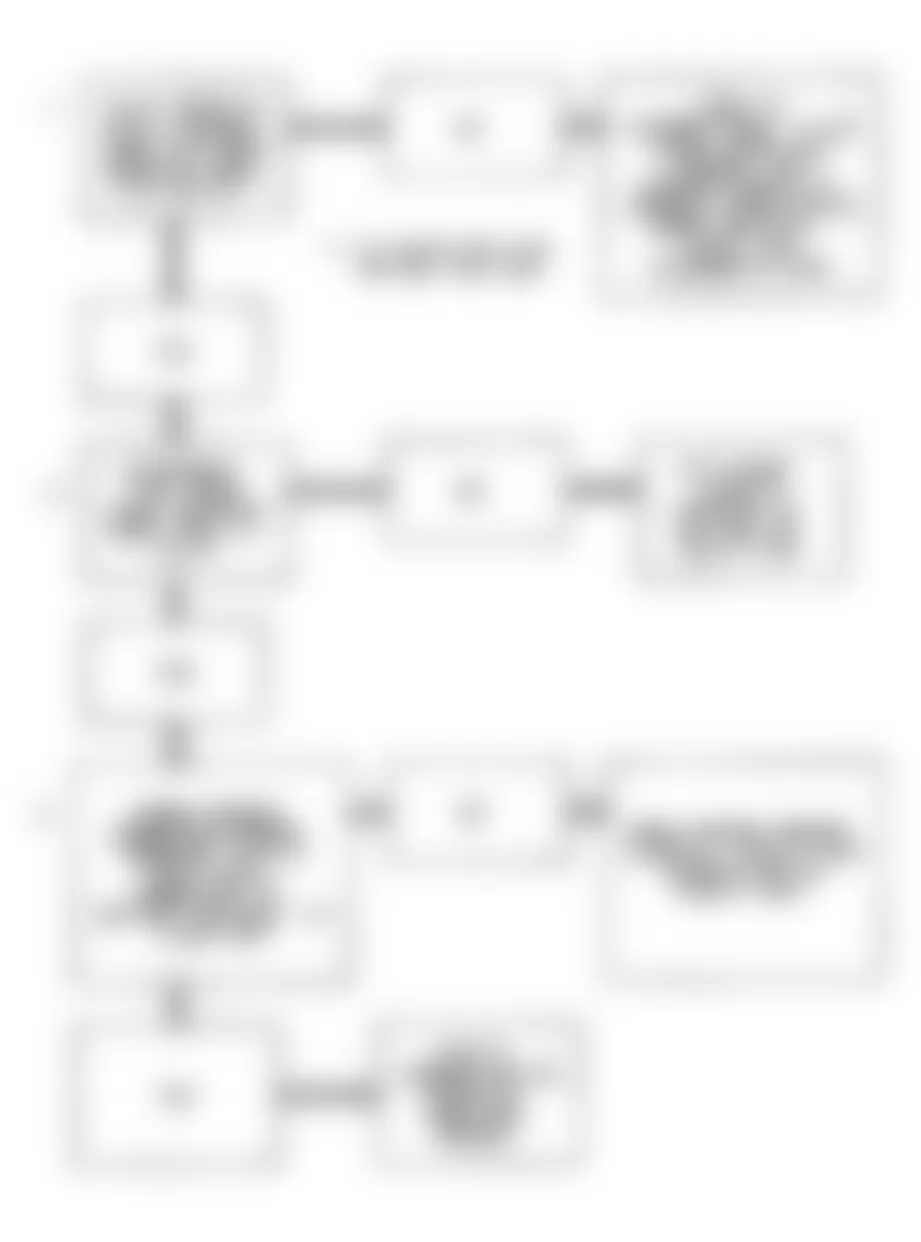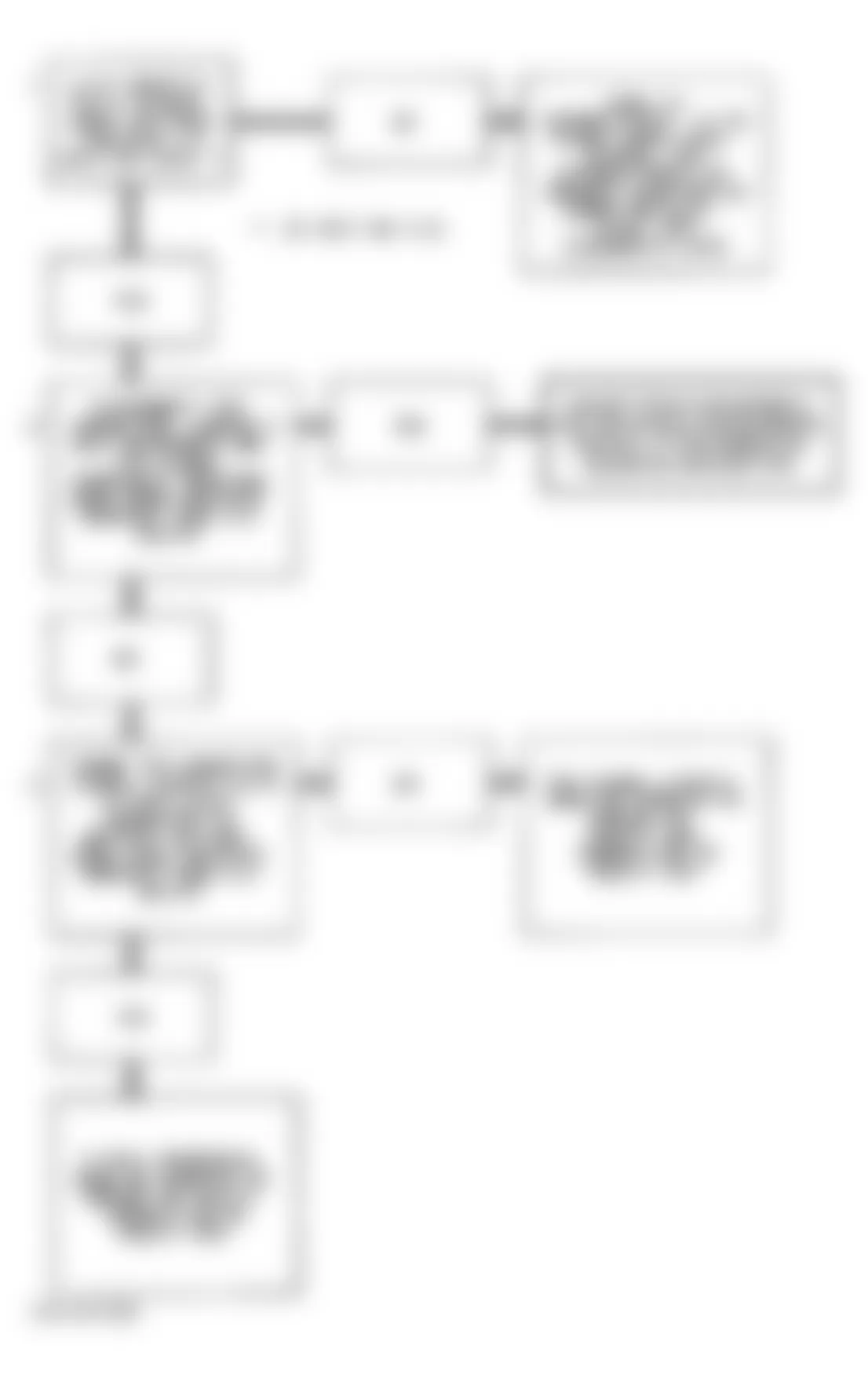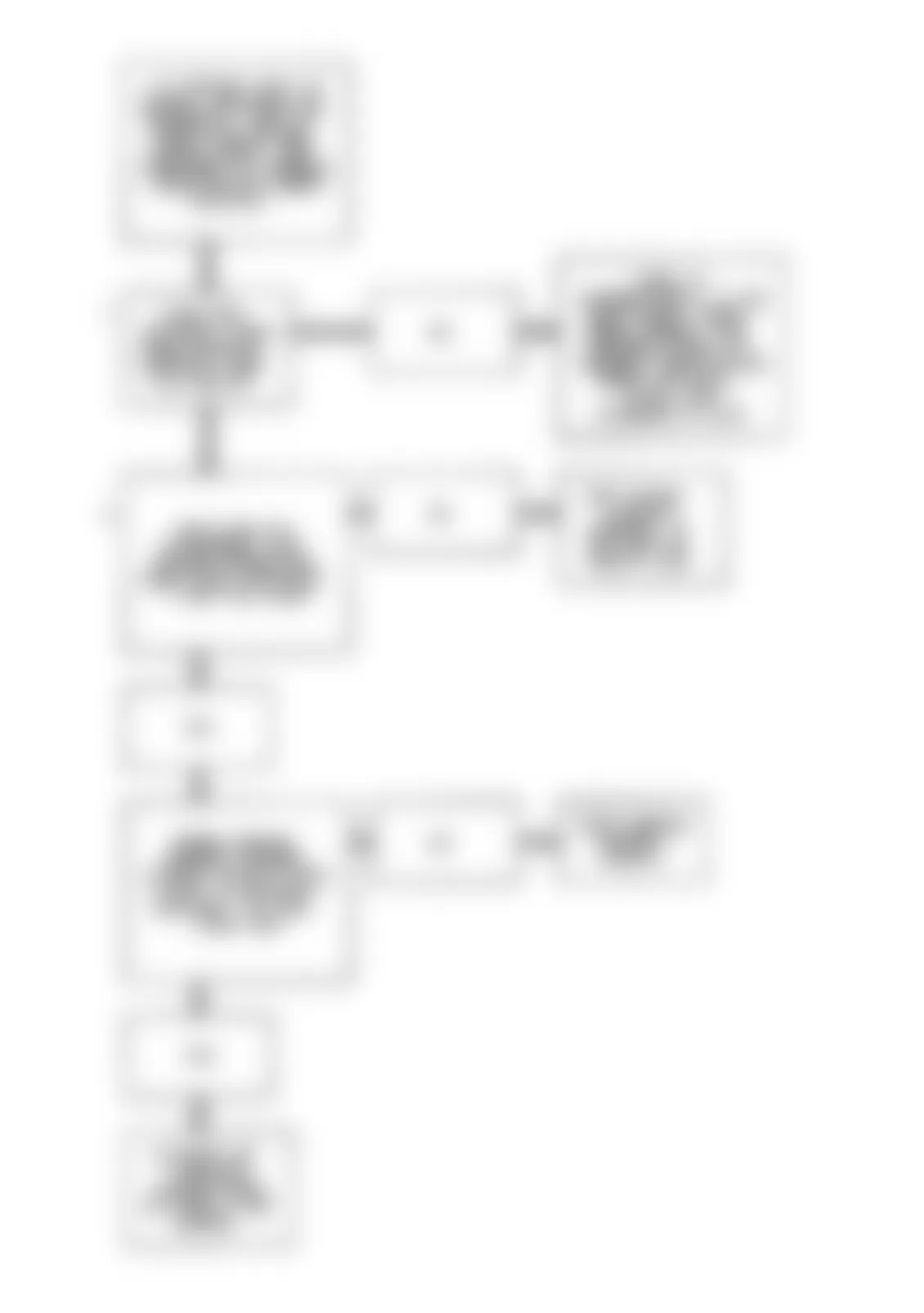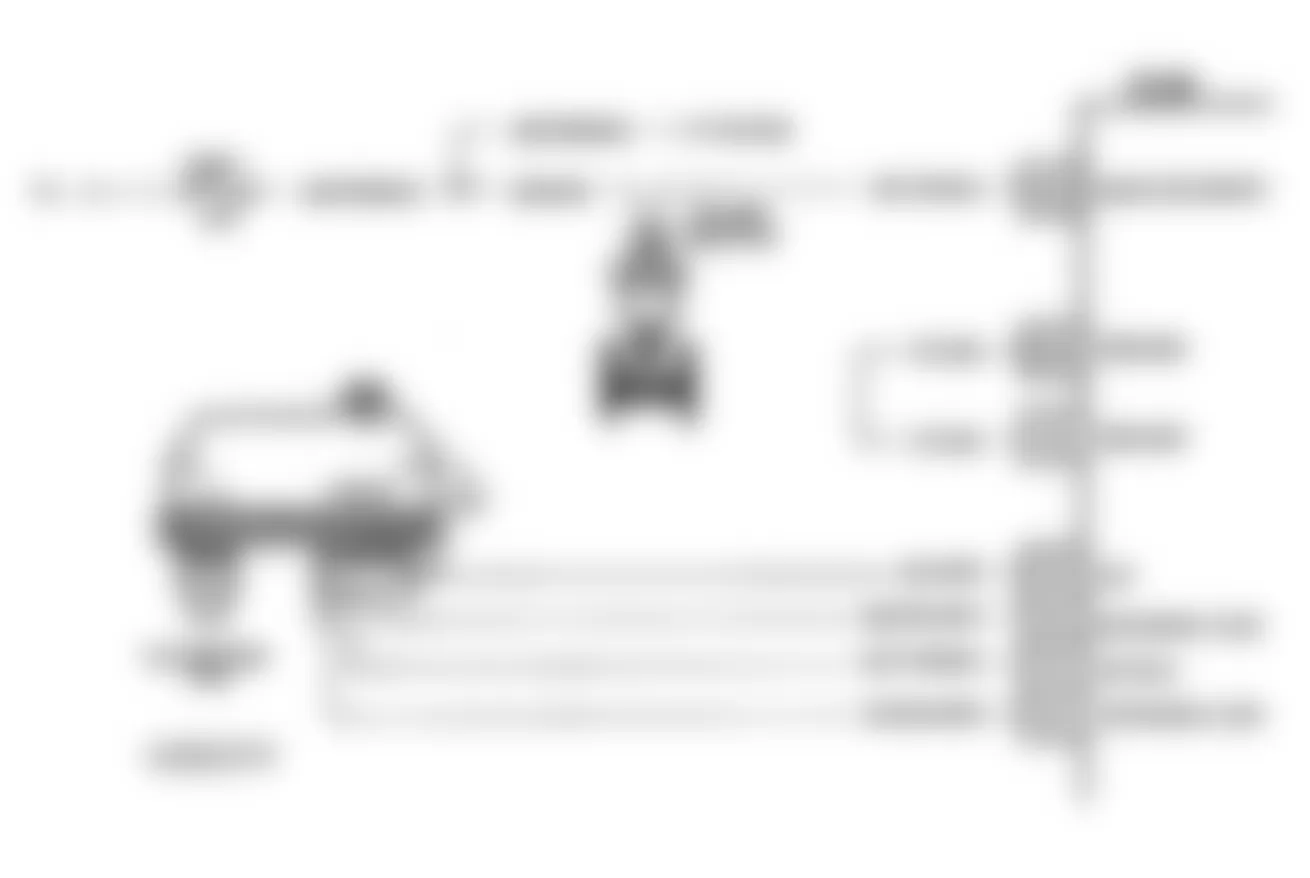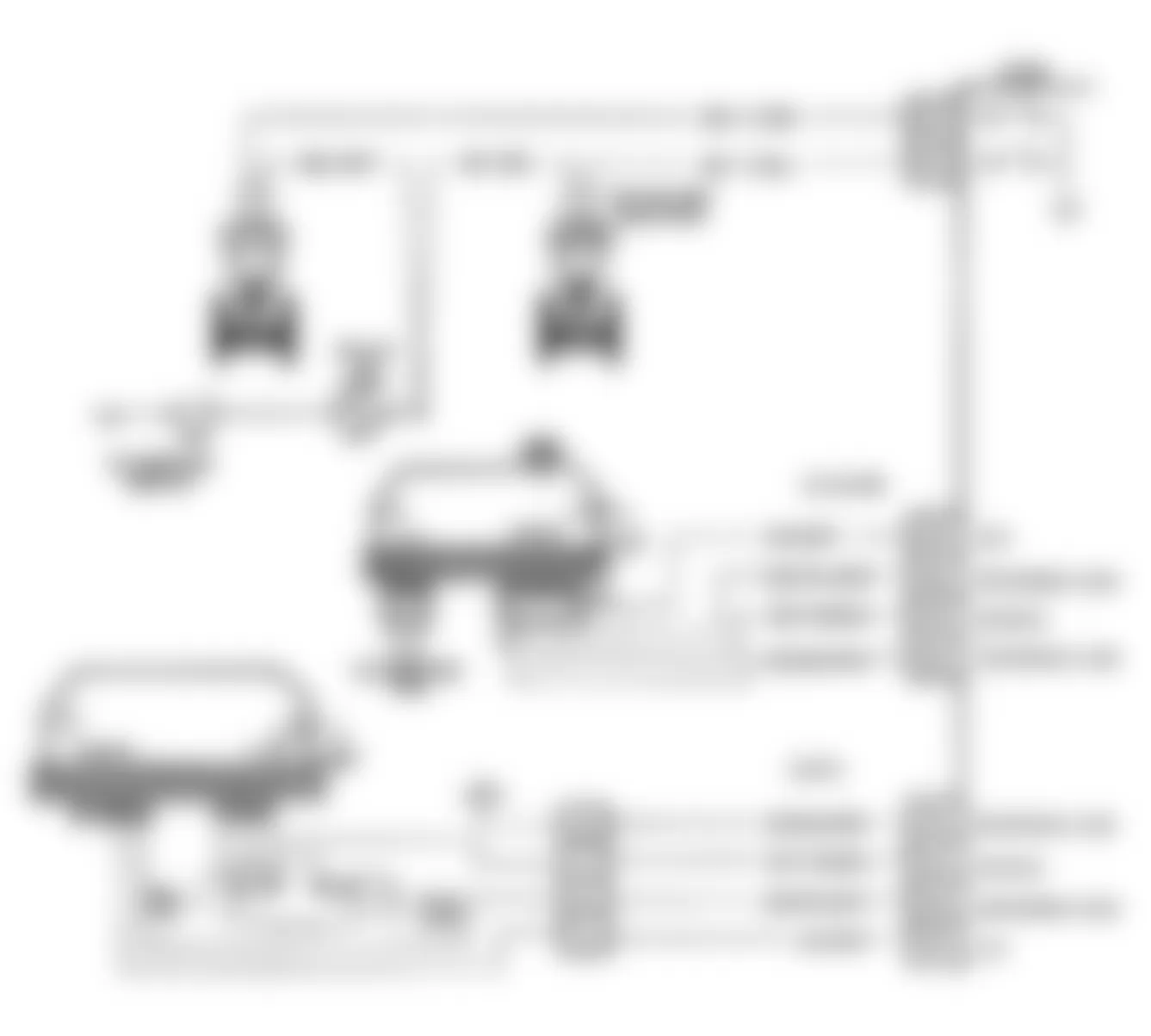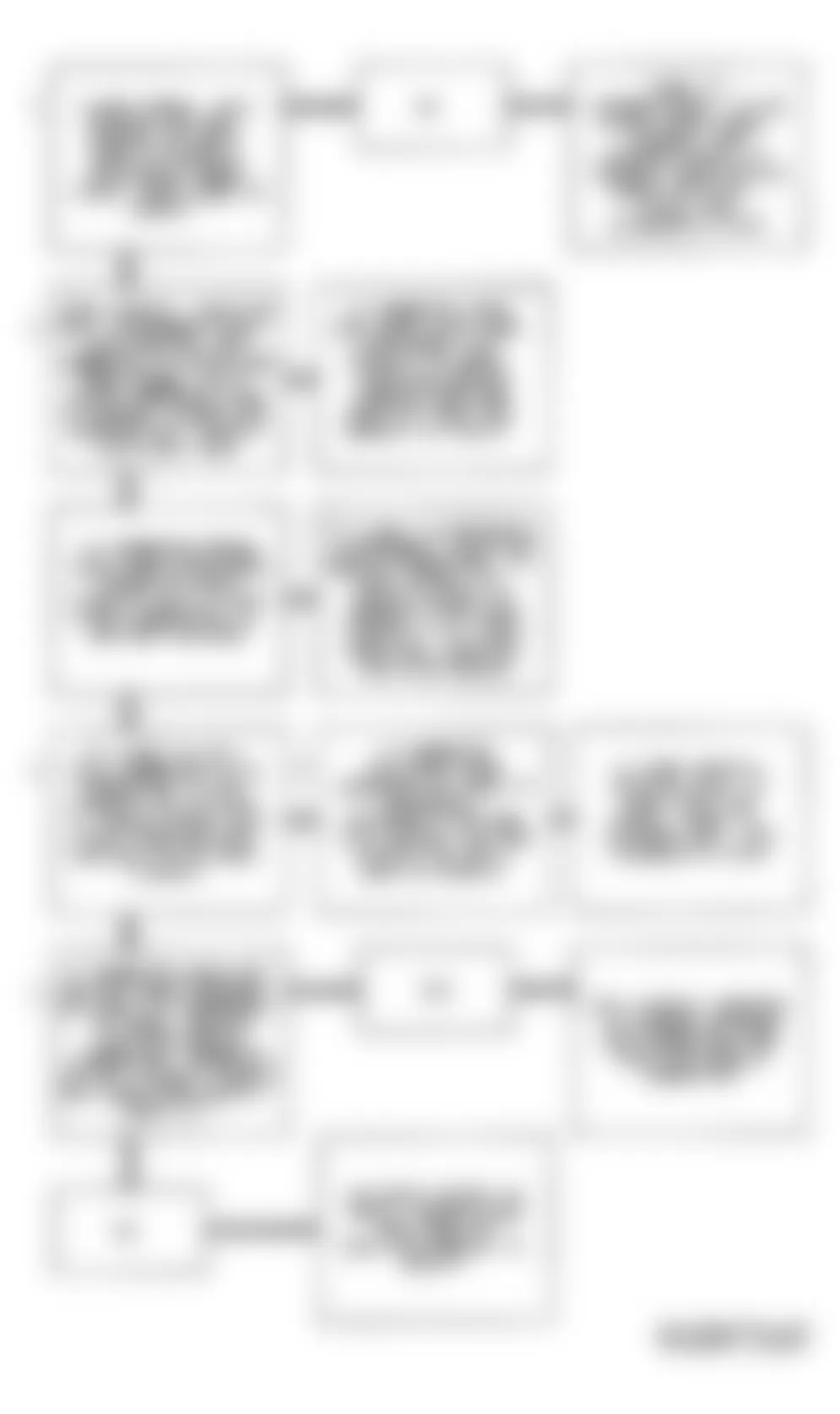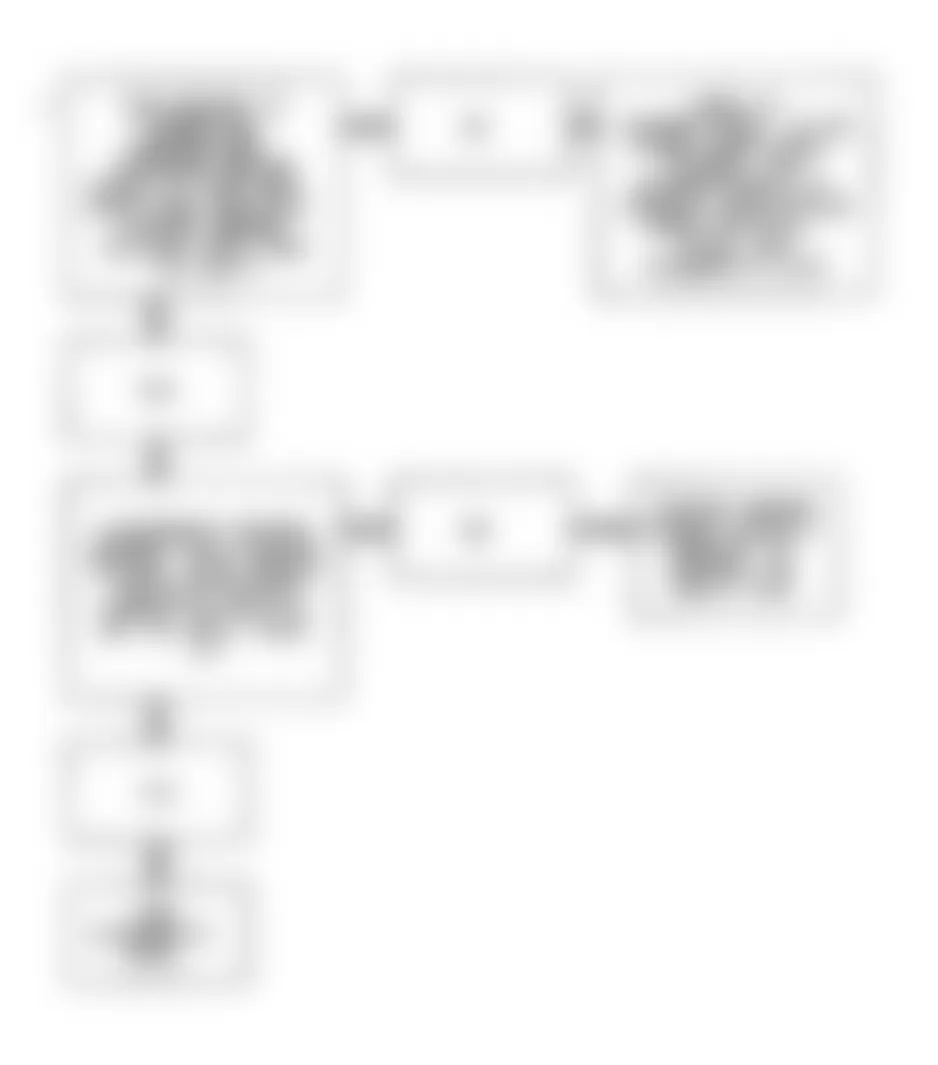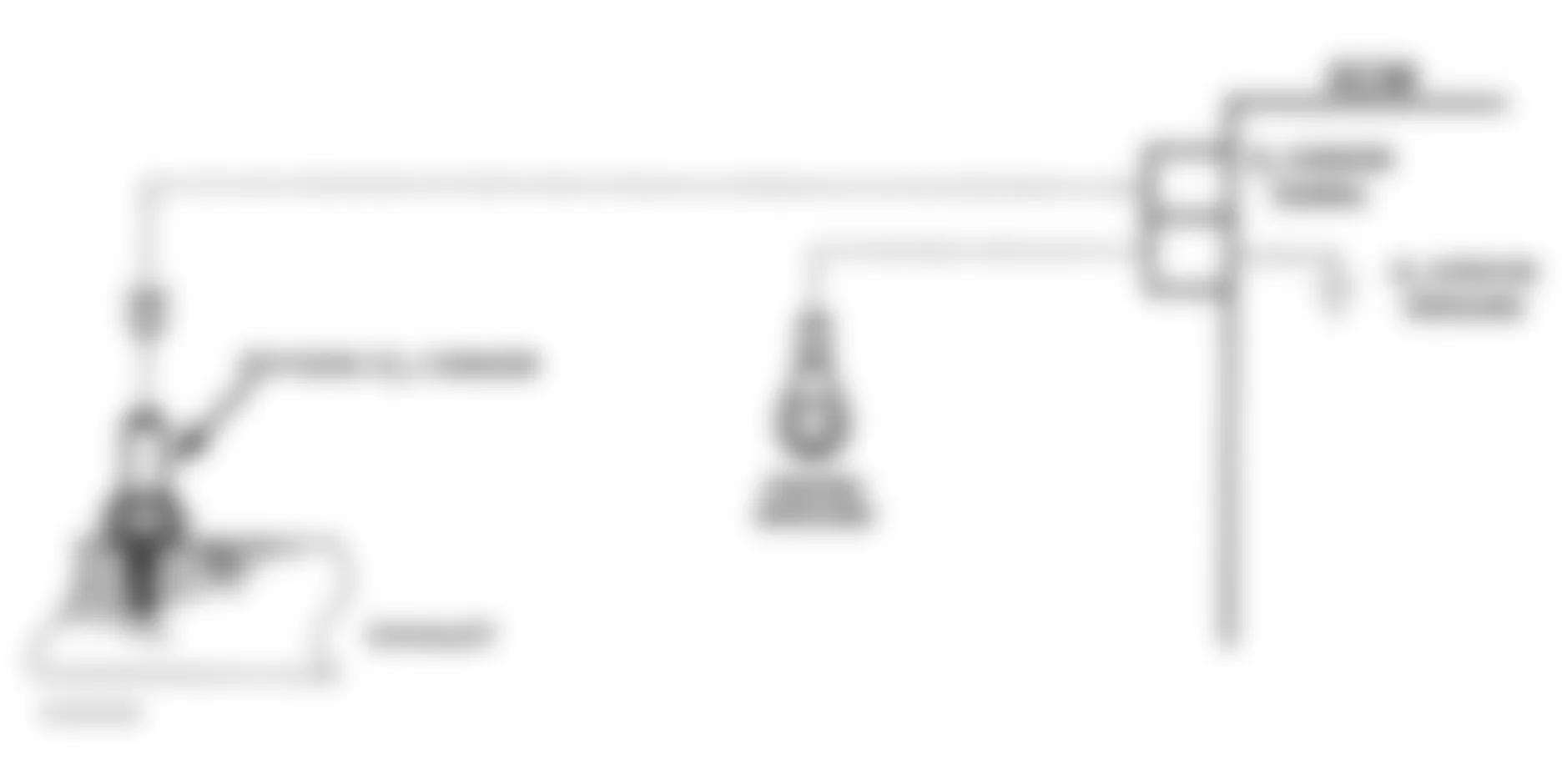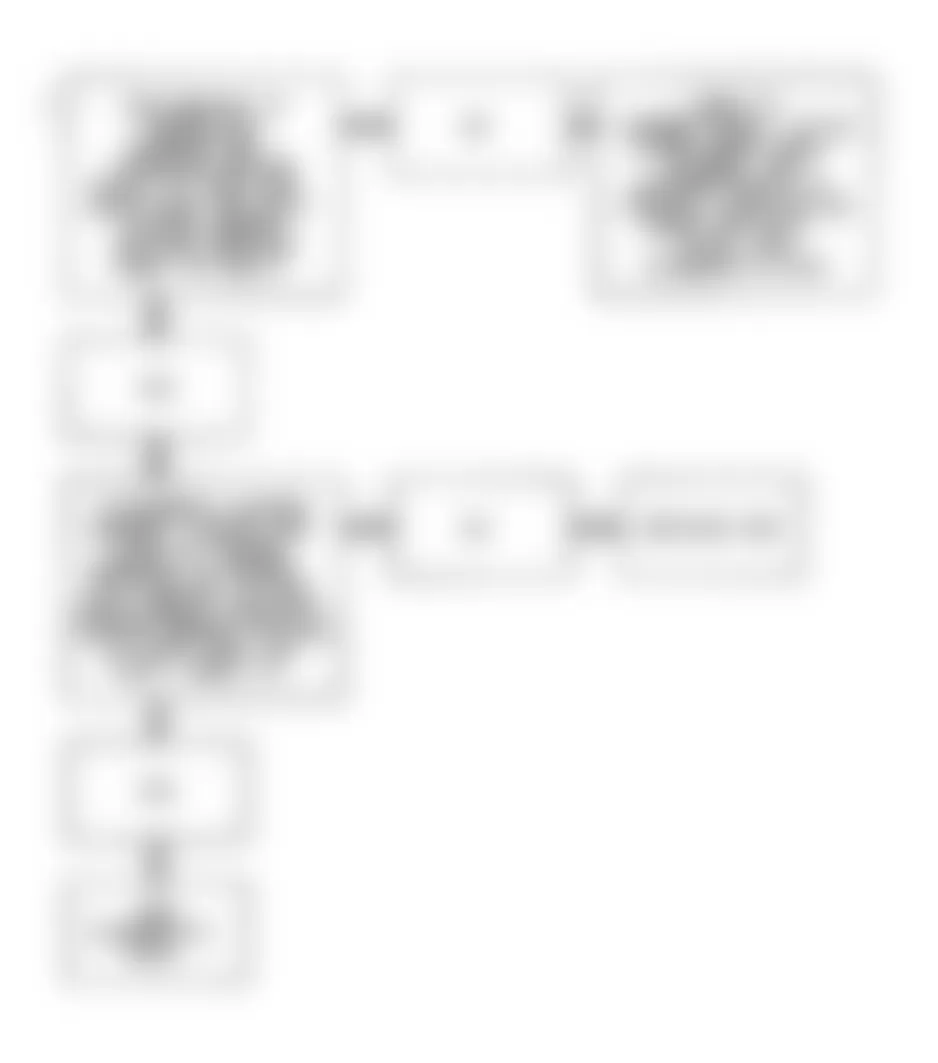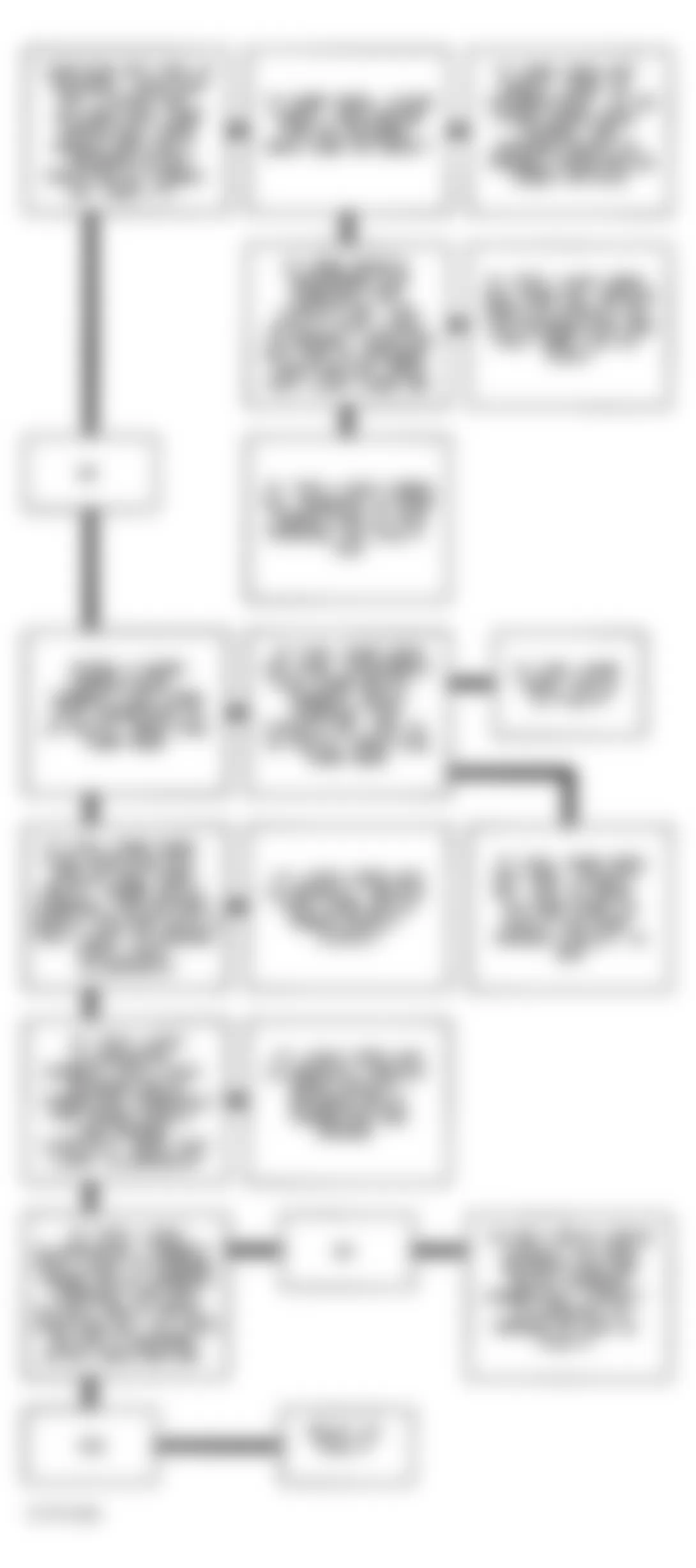Chevrolet S10 Blazer 1992 - G - TESTS W/CODES 1992 ENGINE PERFORMANCE General Motors Corp. Self-Diagnostics Gas (2.5L & 2.8L)
Chevrolet S10 Blazer 1992 - INTRODUCTION
Most engine control problems result from mechanical failures, poor electrical connections or damaged vacuum hoses. Before condemning the computer system, perform checks and inspections covered in BASIC TESTING article in this section. Failure to do so may result in lost diagnostic time.
If no faults were found while performing BASIC DIAGNOSTIC PROCEDURES, proceed with DIAGNOSTIC PROCEDURE. If no fault codes or only a non-running Code 12 is present and driveability problems exist, proceed to TESTS W/O CODES article in this section for diagnosis by symptom (i.e. ROUGH IDLE, NO START, etc.). If only intermittent codes are present, see INTERMITTENTS in TESTS W/O CODES article in this section.
Chevrolet S10 Blazer 1992 - SELF-DIAGNOSTIC SYSTEM
All vehicle are equipped with either an Electronic Control Module (ECM) or Powertrain Control Module (PCM). Unless specifically stated, references to ECM also apply to PCM equipped vehicles.
The ECM is equipped with a self-diagnostic system, which detects system failures or abnormalities. When a malfunction occurs, ECM will illuminate the SERVICE ENGINE SOON light located on instrument panel. When malfunction is detected and light is turned on, a corresponding trouble code will be stored in ECM memory. To retrieve stored codes, see READING TROUBLE CODES. Malfunctions are recorded as HARD FAILURES or as INTERMITTENT FAILURES.
Chevrolet S10 Blazer 1992 - HARD FAILURES
Hard failures cause SERVICE ENGINE SOON light to illuminate and remain on until the malfunction is repaired. If light comes on and remains on (light may flash) during vehicle operation, cause must be found using diagnostic (code) charts. If a sensor fails, control unit will use a substitute value in its calculations to continue engine operation. In this condition, vehicle is functional, but driveability can be poor.
Chevrolet S10 Blazer 1992 - INTERMITTENT FAILURES
Intermittent failures cause SERVICE ENGINE SOON light to flicker or illuminate and go out about 10 seconds after the intermittent fault goes away. The corresponding trouble code; however, will be retained in ECM memory. If related fault does not reoccur within 50 engine restarts, it will be erased from ECM memory. Intermittent failures may be caused by faulty sensor, connector or wiring. See INTERMITTENTS in TESTS W/O CODES article in this section.
Chevrolet S10 Blazer 1992 - DIAGNOSTIC PROCEDURE
Diagnosis of the computerized engine control system should be performed in the following order:
- Ensure all engine systems not related to the computer are operating properly. DO NOT proceed with testing unless all other problems have been repaired. Perform diagnostic circuit check before using trouble code charts. See BASIC TESTING article in this section.
- If trouble codes were displayed (other than Code 12), determine whether codes are hard or intermittent. Hard codes cause SERVICE ENGINE SOON light to illuminate continuously with engine running. See HARD OR INTERMITTENT TROUBLE CODE DETERMINATION. For diagnosing hard codes, proceed to appropriate trouble code chart. For diagnosing intermittent codes, proceed to INTERMITTENTS in TESTS W/O CODES article in this section. Exceptions are Code 13, 15, 24, 44 and 45 charts, which can help diagnose intermittent codes.
- If trouble codes were not displayed and a driveability problem exists, refer to SYMPTOMS in TESTS W/O CODES article in this section. From there you will be sent to the appropriate area in I - SYS/COMP TESTS article in this section.
- After repairs are made, clear trouble codes and perform FIELD SERVICE MODE check in BASIC TESTING article in this section.
Chevrolet S10 Blazer 1992 - RETRIEVING CODES (NON-SCAN)
- Turn ignition on with engine off. SERVICE ENGINE SOON light should glow. Locate Assembly Line Data Link (ALDL) connector, attached to ECM wiring harness. Most ALDL connectors are located under dash on driver's side of vehicle. For exact location of ALDL, see appropriate COMPONENT LOCATIONS illustration in I - SYS/COMP TESTS article in this section. Turn ignition on. Insert jumper wire from terminal "B" (diagnostic test terminal) to terminal "A" (ground) of ALDL connector. See Fig. 1 .
NOTE: Inserting jumper wire into test and ground terminals of ALDL connector with engine running will cause fuel-injected vehicles to enter field service mode and codes will not flash. See FIELD SERVICE MODE in BASIC TESTING article in this section. - SERVICE ENGINE SOON light should flash codes. Each code is flashed 3 times. If codes DO NOT flash, perform DIAGNOSTIC CIRCUIT CHECK in BASIC TESTING article in this section. To exit diagnostic mode, turn ignition off and remove jumper wire from ALDL connector.
Chevrolet S10 Blazer 1992 - READING TROUBLE CODES
NOTE: Trouble codes retrieved from ECM/PCM may be related to either engine or transmission. For engine related codes, use this article. For transmission related codes, see the G - TESTS W/ CODES ELECTRONIC TRANSMISSION article in the ENGINE PERFORMANCE Section. To identify which codes relate to transmission or engine, see TROUBLE CODE IDENTIFICATION table.
The ECM stores component failure information under a related trouble code which can be recalled for diagnosis and repair. Read trouble codes by counting SERVICE ENGINE SOON light flashes or with diagnostic scan tester connected to the ALDL connector. The tester is faster, and capable of reading information which would require testing individual ECM and sensor/solenoid connector terminals with a digital voltmeter. See SCAN TESTER DATA table and SCAN TESTER USAGE.
NOTE: When using a scan tester, there is a time delay between serial data updates. For instantaneous response, a digital voltmeter must be used.
If scan tester is not available, SERVICE ENGINE SOON light flashes can be read by grounding ALDL diagnostic terminal with ignition on and engine off. For example, FLASH, FLASH, pause, FLASH, longer pause, indicates Code 21. The first series of flashes are the first digit of trouble code. The second series of flashes are the second digit of trouble code. Trouble codes are displayed starting with the lowest code. Each code is displayed 3 times and will continue as long as ALDL is grounded.
NOTE: Trouble codes will be recorded at various operating times. Some codes require sensor or switch operation for 5 seconds and others may require longer under certain conditions. Some codes may not set in a service bay operational mode.
Chevrolet S10 Blazer 1992 TROUBLE CODE IDENTIFICATION
Code Probable Cause 12 (1) No Engine Speed Sensor Reference Pulse To PCM/TCM 13 (1) Open Oxygen Sensor Circuit 14 (1) CTS Voltage Low (Sensor Or Signal Line Grounded) 15 (1) CTS Voltage High (Sensor, Connections, Or Wires Open) 21 (1) TPS Voltage High (Open Circuit Or Misadjusted TPS) 22 (1) TPS Voltage Low (Circuit Grounded) 23 (1) Intake Air Temperature Sensor Voltage High 25 (1) Intake Air Temperature Sensor Voltage Low 33 (1) MAP Voltage High (Circuit Open Or Short To Voltage) 34 (1) MAP Voltage Low (Circuit Open Or Short To Ground) 35 (1) IAC System Fault 42 (1) EST Circuit Fault 44 (1) Lean Exhaust Indicated 45 (1) Rich Exhaust Indicated 51 (1) Improperly Installed/Faulty PROM/MEM-CAL 52 (1) Fuel CAL-PAC Missing 53 (1) System Voltage High (Charging System Problem) 54 (1) Fuel Pump Circuit Voltage Low 55 (1) Faulty ECM
(1) Engine code. For transmission code diagnosis, see TESTS W/CODES ELECTRONIC TRANSMISSION article in this section.
NOTE: Trouble code charts should only be used if SERVICE ENGINE SOON light is illuminated (indicating a current problem exists). Exceptions are Code 13, 15, 44 and 45 charts, which may be used to help diagnose intermittent codes. Anytime Codes 51, 52 or 55 are displayed with another code, start with 50-series code first and proceed to low profile numbered codes.
Chevrolet S10 Blazer 1992 - HARD OR INTERMITTENT TROUBLE CODE DETERMINATION
During any diagnostic procedure, determine if codes are due to hard or intermittent failure. Diagnostic charts will not usually help diagnose intermittent codes. To determine hard codes and intermittent codes, proceed as follows:
- MANUALLY enter diagnostic mode. Read and record all stored trouble codes. Exit diagnostic mode and clear trouble codes. See CLEARING TROUBLE CODES.
- Apply parking brake and place transmission in Neutral or Park. Block drive wheels and start engine. SERVICE ENGINE SOON light should go out. Run warm engine at specified curb idle for 2 minutes and note SERVICE ENGINE SOON light.
- If SERVICE ENGINE SOON light comes on, manually enter diagnostic mode. Read and record trouble codes. This reveals hard failure codes. Codes 13, 15, 44, 45 and 55 may require a road test to reset hard failure after trouble codes were cleared.
- If SERVICE ENGINE SOON light does not come on, all stored trouble codes were intermittent failures. Exceptions are noted under DIAGNOSTIC PROCEDURE.
Chevrolet S10 Blazer 1992 - CLEARING TROUBLE CODES
Turn ignition switch to ON position and ground diagnostic test terminal "B" at ALDL connector. Turn ignition switch to OFF position and remove ECM fuse from fuse block for 10 seconds. Replace fuse. Remove diagnostic terminal ground lead.
Chevrolet S10 Blazer 1992 - ECM LOCATION
For ECM locations, see appropriate COMPONENT LOCATIONS illustration in I - SYS/COMP TESTS article in this section.
Chevrolet S10 Blazer 1992 - DIAGNOSTIC MATERIALS Diagnostic Aids
Diagnostic aids (located in many trouble code charts) are provided as additional tips to help with diagnosis when inspected circuit is okay.
Chevrolet S10 Blazer 1992 - Field Service Mode Check
SERVICE ENGINE SOON light indicates operational mode of engine if ALDL is grounded while engine is running. Light response confirms proper fuel system operation and verifies closed loop operation. Clear codes and perform this test after any repair is completed. Field service mode check can be found by proceeding to FIELD SERVICE MODE CHECK in BASIC TESTING article in this section.
Chevrolet S10 Blazer 1992 - SPECIAL TOOLS (DIAGNOSTIC)
NOTE: A special scan tester, plugged into the ALDL, can read trouble codes, check system voltages on the serial data line and save a great deal of time. For additional information, see tester owner's manual. Also, see SCAN TESTER USAGE and SCAN DATA.
The computerized engine control system is most easily diagnosed using a scan tester. However, other tools may aid in diagnosing problems if a scan tester is unavailable. These tools are a tachometer, test light, ohmmeter, digital voltmeter with 10-megohm input impedance (minimum), vacuum pump, vacuum gauge, fuel injector test lights and 6 jumper wires 6" long (one wire with female connectors at both ends, one wire with male connector at both ends and 4 wires with male and female connectors at opposite ends). A test light, rather than a voltmeter, must be used when indicated by a diagnostic chart.
Chevrolet S10 Blazer 1992 - SCAN TESTER USAGE
NOTE: Before connecting scan tester, check diagnostic system and ensure accurate information is received by scan tester. Perform DIAGNOSTIC CIRCUIT CHECK in BASIC TESTING article in this section. If vehicle does not pass diagnostic circuit check, information received by scan tester may be invalid.
The scan tester is a specialized tester which can diagnose on-board computer control systems by providing almost instant access to circuit voltage information without crawling under dash or hood to back-probe sensors and connectors. scan testers reduce diagnostic time by furnishing input data (voltage signals) which can be compared to specification parameters. See SCAN TESTER DATA table.
Scan testers also furnish information on output device (solenoids and motors) status. However, status parameters are only an indication output signals have been sent to devices by the ECM. They do not indicate whether devices respond properly to that signal. This must be verified at output device using a voltmeter or test light.
NOTE: Code 12 should always exist when ALDL is grounded with key on and engine off, but it may not be indicated by all makes of scan tester.
If trouble codes are not present, a problem may still exist. Driveability-related problems with codes displayed occur about 20 percent of the time, while driveability problems without codes occur about 80 percent of the time. Out-of-calibration sensors WILL NOT set a trouble code, but WILL cause driveability problems. A scan tester is the easiest method of checking sensor specifications and other data parameters. Tester is also useful in finding intermittent wiring problems by wiggling wiring harnesses and connections (key on, engine off) while observing data parameters. See SCAN TESTER DATA table.
NOTE: Information obtained by scan tester is only as accurate as the tester itself. If erroneous voltage signals are suspected, verify tester information using a digital voltmeter and wiring schematic. If non-existent codes are displayed, turn ignition off and remove tester. Turn ignition on and ground ALDL test terminal. If same codes are not flashed by SERVICE ENGINE SOON light as were indicated by scan tester, tester cannot be used on vehicle and information obtained by it will not be guaranteed accurate.
Chevrolet S10 Blazer 1992 - SCAN DATA
NOTE: Information contained in the following table is typical of readings taken on vehicle with engine idling, upper radiator hose hot, throttle closed, transmission in Park or Neutral, closed loop status achieved and all accessories off (except as noted in tables). Data parameters are updated every 1 1/2 seconds. Not all devices and systems are used on all models. For additional information, see tester owner's manual.
Chevrolet S10 Blazer 1992 SCAN TESTER DATA
Tester Position Units Measured Nominal Value A/C Clutch On/Off Off (On With A/C) A/C Request Yes/No No/Yes (With Request) Battery Voltage Volts 13.5-14.5 Block Learn Counts 118-138 (128 Normal) Clear Flood On/Off See Tester Manual Coolant Temp. ?C 85-105? (Norm. Temperature) Crank RPM RPM 100-900 Cross Counts Counts 0-255 Desired RPM RPM ECM Desired RPM EGR Duty Cycle 0-100% 0/Closed-100/Fully Open IAC Counts 0-50Injector Pulse Width Mil./Sec .8-3.0 INT (Integrator) Counts 110-145 (128 Normal) Knock Retard (ESC) Counts 0-255 Knock Signal Yes/No Yes When Knock Exists MAT ?C 10-90? MAP Volts 1 (idle) To 4.5 (WOT) Open/Closed Loop Status Ol/Cl Closed/Open During Extended Idle O2 Sensor Millivolts 100 (Lean) To 999 (Rich) P/N Switch P/N/RDL Park/Neutral P/S Switch Norm/Hi Normal PROM I.D. PROM # Original Factory Number RPM RPM Spec. +/-25 RPM Drive (A/T) RPM RPM Spec. +/-50 RPM Neut. (M/T) TCC On/Off Off (On With Command) TPS Volts 1.25 (Idle) To 5.0 (WOT) Throttle Angle 0-100% 0 (Idle) To 100 (WOT) Trouble Codes Code # No codes Upshift Light(Man. Trans.) On/Off Off VSS Or MPH MPH 0-Actual 4th Gear Switch On/Off On/4th Gear
Chevrolet S10 Blazer 1992 - SUMMARY
If hard fault codes are not present and driveability symptoms or intermittent codes exist, proceed to TESTS W/O CODES article in this section for diagnosis by symptom (i.e. ROUGH IDLE, NO START, etc.), or intermittent diagnostic procedures.
NOTE: The following diagnostic flow charts and mini-schematics are supplied courtesy of General Motors Corp.
Chevrolet S10 Blazer 1992 - TROUBLE CODES CODE 13, OPEN OXYGEN SENSOR CIRCUIT
When exhaust temperature is less than 600?F (316?C), O2 sensor is open and produces no voltage. An open sensor circuit or cold sensor will not allow system to entire closed loop.
NOTE: Test numbers refer to test numbers on diagnostic chart.
- Code 13 will set at normal operating temperature if at least 2 minutes have passed since engine start, Code 21 or 22 is not present, O2 signal voltage is steady at .35-.55 volt and throttle position sensor signal is greater than idle. All conditions must be met for at least one minute.
- This determines if fault is in O2 sensor, ECM or wiring.
- Use only a high-impedance Digital Volt-Ohmmeter (DVOM) while checking for continuity in signal and ground circuits. If ground circuit is open, voltage on signal circuit will be greater than .6 volt.
Chevrolet S10 Blazer 1992 - Diagnostic Aids
Verify a clean, tight connection for ground circuit No. 413. An open circuit at sensor signal terminal or ground terminal will result in a Code 13.
Chevrolet S10 Blazer 1992 CODE 13 ECM TERMINAL & CIRCUIT WIRING IDENTIFICATION
Application ECM Terminal Wire Color 2.5L & 2.8L "S" & "T" Series Oxygen Sensor Signal D7 Purple Oxygen Sensor Ground D6 Tan
Chevrolet S10 Blazer 1992 - CODE 14, COOLANT SENSOR SIGNAL VOLTAGE LOW
ECM uses coolant temperature sensor inputs in determining control of fuel delivery, engine timing (EST), idle (IAC) and converter clutch (TCC). As engine warms, sensor resistance reduces. At normal operating temperature, voltage signal will be about or 1.5-2.0 volts at ECM coolant sensor signal terminal.
NOTE: Test numbers refer to test numbers on diagnostic chart.
- This tests if code was set because of a hard failure or intermittent condition. Code 14 sets if signal voltage indicates a coolant temperature greater than 275?F (135?C) for more than 6 seconds on all other models.
- This simulates conditions for a Code 15. If ECM recognizes open circuit by displaying a low temperature, ECM and wiring are not at fault.
Chevrolet S10 Blazer 1992 - Diagnostic Aids
After engine is started, temperature should rise steadily to about 194?F (90?C), then stabilize when thermostat opens. If engine is allowed to cool overnight, coolant temperature sensor and MAT sensor (if equipped) should read close to each other, when measured with a scan tester.
Chevrolet S10 Blazer 1992 CODE 14 ECM TERMINAL & CIRCUIT WIRING IDENTIFICATION
Application ECM Terminal Wire Color 2.8L CTS Signal C10 Yellow CTS Ground D2 Black 2.5L & 2.8L "S" & "T" Series CTS Signal C10 Yellow CTS Ground A11 Black
Chevrolet S10 Blazer 1992 TEMPERATURE-TO-RESISTANCE VALUES (1) (2)
?F (?C) Ohms 210 (100) 185 160 (70) 450 100 (38) 1800 70 (20) 3400 40 (4) 7500 20 (-7) 13,500 0 (-18) 25,000 -40 (-40) 100,700
(1) Measure resistance across sensor terminals.
(2) Temperatures are approximates.
Chevrolet S10 Blazer 1992 - CODE 15, COOLANT SENSOR SIGNAL VOLTAGE HIGH
As engine warms, sensor resistance reduces and voltage drops. At normal operating temperature, voltage signal will be about 1.5-2.0 volts (all other models) at ECM coolant sensor signal terminal. If sensor signal circuit opens, ECM will see -40?F (-40?C) and deliver fuel for this temperature.
NOTE: Test numbers refer to test numbers on diagnostic chart.
- This checks if code was set as a result of a hard failure or intermittent condition. Code 15 will set if engine is running for more 50 seconds and signal voltage indicates a coolant temperature less than -22?F (-30?C) for more than 30 seconds.
- This simulates conditions for a Code 14. If ECM recognizes grounded circuit and displays a high temperature, ECM and wiring are okay.
- This determines if problem is ECM or wiring. There should be 5 volts present at sensor when measured with a DVOM.
Chevrolet S10 Blazer 1992 - Diagnostic Aids
After engine starts, temperature should rise steadily to about 194?F (90?C) and stabilize when thermostat opens. If engine is allowed to cool overnight, coolant temperature sensor and MAT sensor (if equipped) should read close to each other when measured with a scan tester. Code 15 will also set if sensor signal or ground circuit is open.
Chevrolet S10 Blazer 1992 CODE 15 ECM TERMINAL & CIRCUIT WIRING IDENTIFICATION
Application ECM Terminal Wire Color 2.8L CTS Signal C10 Yellow CTS Ground D2 Black 2.5L & 2.8L "S" & "T" Series CTS Signal C10 Yellow CTS Ground A11 Black
Chevrolet S10 Blazer 1992 TEMPERATURE-TO-RESISTANCE VALUES (1) (2)
?F (?C) Ohms 210 (100) 185 160 (70) 450 100 (38) 1800 70 (20) 3400 40 (4) 7500 20 (-7) 13,500 0 (-18) 25,000 -40 (-40) 100,700
(1) Measure resistance across sensor terminals.
(2) Temperatures are approximates.
Chevrolet S10 Blazer 1992 - CODE 21, TPS SIGNAL VOLTAGE HIGH
Throttle Position Sensor (TPS) provides a varying voltage signal depending on throttle valve angle. Signal voltage varies from about .50 volt at idle to 4.5 volts at wide open throttle. On models with non-adjustable TPS, each time TPS voltage drops to less than 1.25 volts and stops, ECM assumes this is zero degrees throttle angle and measures throttle percentage angle from this point.
NOTE: Test numbers refer to test numbers on diagnostic chart.
- This test confirms Code 21 and checks if fault is a hard failure or an intermittent condition. Code 21 will set if TPS voltage is greater than 2.5 volts 2-10 seconds with engine running. On 2.8L, Code 21 may set if MAP sensor signal less than 2 volts.
- This test simulates conditions for Code 22. If ECM recognizes low voltage signal and sets Code 22, ECM and power and signal circuits are not at fault.
- This step isolates a faulty sensor, ECM or an open ground circuit.
Chevrolet S10 Blazer 1992 - Diagnostic Aids
A scan tester displays throttle position in volts. Closed throttle voltage should be less than 1.25 volts (all other models). TPS voltage should increase at a steady rate to about 4.5 volts as throttle angle increases. Code 21 will also result if ground circuit is open or TPS signal circuit is shorted to voltage.
Chevrolet S10 Blazer 1992 CODE 21 ECM TERMINAL & CIRCUIT WIRING IDENTIFICATION
Application ECM Terminal Wire Color 2.8L TPS Signal C13 Dark Blue TPS Ground D2 Black TPS Reference C14 Gray 2.5L & 2.8L "S" & "T" Series TPS Signal C13 Dark Blue TPS Ground A11 Black TPS Reference C14 Gray
Chevrolet S10 Blazer 1992 - CODE 22, TPS SIGNAL VOLTAGE LOW
Throttle Position Sensor (TPS) provides a varying voltage signal depending on throttle valve angle. Signal voltage varies from less than about .50 volt at idle to 4.5 volts at wide open throttle.
NOTE: Test numbers refer to test numbers on diagnostic chart.
- This test confirms Code 22 and tests if fault is a hard failure or an intermittent condition. Code 22 will set if engine is running, TPS voltage is less than .2 volt for 2-4 seconds.
- This simulates Code 21. If ECM recognizes a high voltage signal and sets Code 21, ECM and wiring are not at fault. On 2.8L, check and adjust TPS. On all others, replace TPS.
- This simulates a high voltage signal to check for on open TPS signal circuit.
Chevrolet S10 Blazer 1992 - Diagnostic Aids
A scan tester displays throttle position in volts. Closed throttle voltage should be less than 1.25 volts (all other models). TPS voltage should increase at a steady rate to about 4.5 volts as throttle angle increases. Code 22 will also set if TPS signal or ground circuits are open or grounded.
Chevrolet S10 Blazer 1992 CODE 22 ECM TERMINAL & CIRCUIT WIRING IDENTIFICATION
Application ECM Terminal Wire Color 2.8L TPS Signal C13 Dark Blue TPS Ground D2 Black TPS Reference C14 Gray 2.5L & 2.8L "S" & "T" Series TPS Signal C13 Dark Blue TPS Ground A11 Black TPS Reference C14 Gray
Chevrolet S10 Blazer 1992 - CODE 23, MAT SENSOR TEMP. LOW (2.5L)
ECM supplies and monitors a voltage signal (4-6 volts) to sensor. When temperatures are low, sensor resistance is high and ECM will see a high-monitored voltage signal. As temperature increases, sensor resistance decreases and voltage sensed by ECM drops.
NOTE: Test numbers refer to test numbers on diagnostic chart.
- This checks if Code 23 is a hard failure or an intermittent condition. Code 23 will set if engine is running for one minute, MAT sensor temperature is less than -22?F (-30?C) for 12 seconds and speed sensor signal is not present.
- This simulates conditions for a Code 25. If scan tester displays a high temperature, ECM and wiring are not at fault.
- This checks for continuity of sensor signal and ground circuits.
Chevrolet S10 Blazer 1992 - Diagnostic Aids
If engine is allowed to cool overnight, coolant and MAT sensors should read close to each other, when measured with a scan tester. A Code 23 will also result if signal and ground circuits become open.
Chevrolet S10 Blazer 1992 CODE 23 ECM TERMINAL & CIRCUIT WIRING IDENTIFICATION
Application ECM Terminal Wire Color 2.5L Signal C12 Tan MAT Ground D2 Black/Orange
Chevrolet S10 Blazer 1992 TEMPERATURE-TO-RESISTANCE VALUES (1) (2)
?F (?C) Ohms 210 (100) 185 160 (70) 450 100 (38) 1800 70 (20) 3400 40 (4) 7500 20 (-7) 13,500 0 (-18) 25,000 -40 (-40) 100,700
(1) Measure resistance across sensor terminals.
(2) Temperatures are approximates.
Chevrolet S10 Blazer 1992 - CODE 25, MAT SENSOR TEMP. HIGH (2.5L)
ECM applies and monitors a voltage signal (4-6 volts) to MAT sensor. When manifold air is cold, sensor resistance is high and ECM sees a high signal voltage. As air warms, resistance decreases and voltage sensed by ECM drops. Sensor resistance can be measured at sensor terminals with harness disconnected.
NOTE: Test numbers refer to test numbers on diagnostic chart.
- This checks if code is a hard failure or an intermittent condition. Code 25 will set if a VSS signal is present (2.5L) and monitored MAT sensor temperature is greater than 302?F (150?C) for 2.5L.
- This simulates conditions for a Code 23. If scan tester displays a low temperature, ECM and wiring are not at fault.
Chevrolet S10 Blazer 1992 - Diagnostic Aids
If engine is allowed to cool overnight, coolant temperature sensor and MAT sensor should read close to each other, when measured with a scan tester. A Code 25 will also result if sensor signal circuit is shorted to ground.
Chevrolet S10 Blazer 1992 CODE 25 ECM TERMINAL & CIRCUIT WIRING IDENTIFICATION
Application ECM Terminal Wire Color 2.5L Signal C12 Tan MAT Ground D2 Black/Orange
Chevrolet S10 Blazer 1992 TEMPERATURE-TO-RESISTANCE VALUES (1) (2)
?F (?C) Ohms 210 (100) 185 160 (70) 450 100 (38) 1800 70 (20) 3400 40 (4) 7500 20 (-7) 13,500 0 (-18) 25,000 -40 (-40) 100,700
(1) Measure resistance across sensor terminals.
(2) Temperatures are approximates.
Chevrolet S10 Blazer 1992 - CODE 33, MAP SENSOR SIGNAL VOLTAGE HIGH
Manifold Absolute Pressure (MAP) sensor responds to changes in manifold pressure (vacuum). If MAP sensor fails, ECM will substitute a fixed MAP value and use TPS input to control fuel delivery.
NOTE: Test numbers refer to test numbers on diagnostic chart.
- This test confirms Code 33 and determines if it is a hard failure or an intermittent condition. Code 33 will set when voltage signal reading is too high and TPS voltage indicates throttle is closed.
- This step simulates conditions for a Code 34. If ECM recognizes and indicates low MAP signal, ECM and 5-volt reference and MAP signal circuits are not at fault.
Chevrolet S10 Blazer 1992 - Diagnostic Aids
With ignition switch in ON position and engine off, manifold pressure is equal to atmospheric pressure and signal voltage is high. Comparing BARO readings from a known good vehicle using the same sensor is a good way to check accuracy of suspected sensor. Readings should be within .4 volt of each other. Code 33 will also result if ground circuit is open or MAP signal circuit is shorted to voltage or to 5-volt reference circuit.
Chevrolet S10 Blazer 1992 CODE 33 ECM TERMINAL & CIRCUIT WIRING IDENTIFICATION
Application ECM Terminal Wire Color 2.5L "S" & "T" Series MAP Signal C11 (1) Light Green MAP Ground D2 Black/Red MAP Reference C14 Gray 2.8L MAP Signal C11 (1) Light Green MAP Ground A11 Purple MAP Reference C14 Gray
(1) May have a Black trace.
Chevrolet S10 Blazer 1992 - CODE 34, MAP SENSOR SIGNAL VOLTAGE LOW
Manifold Absolute Pressure (MAP) sensor responds to changes in manifold pressure (vacuum). If MAP sensor fails, ECM will substitute a fixed MAP value and use TPS input to control fuel delivery.
NOTE: Test numbers refer to test numbers on diagnostic chart.
- This confirms Code 34 and determines if code was a hard failure or an intermittent condition. Code 34 will set when ignition is on and MAP signal voltage is low. On some systems, engine must be running to set code.
- Jumpering harness terminals "B" to "C" will determine if problem is sensor, ECM or wiring. If ECM recognizes and indicates high MAP signal, ECM and wiring are okay.
- Scan tester may not display 12 volts. The important thing is that the ECM recognizes voltage as greater than 4 volts (high MAP voltage signal), indicating ECM and MAP signal circuit are not at fault.
Chevrolet S10 Blazer 1992 - Diagnostic Aids
With ignition switch in ON position and engine off, manifold pressure is equal to atmospheric pressure and signal voltage will be high. Comparing BARO readings with a known good vehicle using the same sensor is a good way to check accuracy of suspected sensor. Readings should be within .4 volt of each other. A Code 34 will also result if 5-volt reference and MAP signal circuits are open or shorted to ground. If 5-volt reference circuit is not shorted to ground and a Code 22 is stored, check MAP signal circuit for short to ground.
Chevrolet S10 Blazer 1992 CODE 34 ECM TERMINAL & CIRCUIT WIRING IDENTIFICATION
Application ECM Terminal Wire Color 2.5L "S" & "T" Series MAP Signal C11 (1) Light Green MAP Ground D2 Black/Red MAP Reference C14 Gray 2.8L MAP Signal C11 (1) Light Green MAP Ground A11 Purple MAP Reference C14 Gray
(1) May have a Black trace.
Chevrolet S10 Blazer 1992 - CODE 35, IDLE SPEED ERROR (2.5L)
Code 35 will set when closed throttle engine speed is 150 RPM greater or less than correct idle speed for 20 seconds.
NOTE: Test numbers refer to test numbers on diagnostic chart.
- IAC driver is used to extend and retract IAC valve. Movement is verified by changing engine speed. If no engine speed change occurs, valve can be retested when removed from throttle body.
- Checks IAC movement quality from step 1). Between 700-1500 RPM, engine speed should change smoothly with each tester light flash while extending or retracting. If IAC valve is retracted beyond control range (about 1500 RPM), it may take many flashes in extend position before engine speed reduces. This is normal on some engines. Fully extending IAC may cause engine to stall. This may be normal.
- Steps 1) and 2) verified proper IAC valve operation. This step checks IAC circuits. Each light on node light should flash Red and Green, while IAC valve is cycled. While color sequence is not important, if either light is off or does not flash Red and Green, check circuits beginning with poor terminal contacts.
Chevrolet S10 Blazer 1992 - IAC VALVE RESET PROCEDURE
Turn ignition off for 10 seconds. Start and run engine for 5 seconds. Turn ignition off another 10 seconds.
Chevrolet S10 Blazer 1992 - Diagnostic Aids
A slow, unstable idle may be caused by a system problem that cannot be overcome by IAC. Scan counts will be greater than 60 if too low, and zero counts if too high. If idle is too high, stop engine. With ignition on, ground ALDL test terminal "B". Wait 45 seconds for IAC to seat, then disconnect IAC. Start engine. If idle speed is greater than 800 RPM, inspect vehicle for vacuum leaks.
Chevrolet S10 Blazer 1992 - System Too Lean
If air/fuel ratio is too lean, idle speed may be either too high (check for vacuum leaks) or too low. Engine speed may vary and disconnecting IAC may not help. Scan tester and/or digital voltmeter (10 megohm) will read an oxygen sensor output less than 300 mv (.3 volt). Check for low fuel pressure or water in fuel.
Chevrolet S10 Blazer 1992 - System Too Rich
If air/fuel ratio is too rich, idle speed will be too low and scan tester counts will usually be greater than 80. The system may be obviously rich with Black smoke from tailpipe. Scan tester and/or voltmeter will read an oxygen sensor voltage signal fixed greater than 800 mv (.8 volt). Look for high fuel pressure or leaking/sticky injectors. Remove IAC and inspect bore for foreign material or evidence of IAC valve dragging bore. A silicone-contaminated oxygen sensor will produce lean air/fuel mixture. Oxygen sensor output would be fixed greater than 800 mv (.8 volt). This may also set Code 45.
Chevrolet S10 Blazer 1992 - Throttle Body
Remove IAC and inspect bore for evidence of IAC valve dragging.
Chevrolet S10 Blazer 1992 - IAC Valve Connections
Carefully inspect connections for looseness or corrosion.
Chevrolet S10 Blazer 1992 - PCV Valve
The wrong PCV valve may cause incorrect idle speed.
Chevrolet S10 Blazer 1992 CODE 35 ECM TERMINAL & CIRCUIT WIRING IDENTIFICATION
Application ECM Terminal Wire Color 2.5L A Coil High C5 Light Blue/White A Coil Low C6 Light Blue/Black B Coil High C4 Light Green/White B Coil Low C3 Light Green/Black
Chevrolet S10 Blazer 1992 - CODE 42, ELECTRONIC SPARK TIMING
NOTE: For applicable schematic, see previous page.
Code 42 indicates ECM has seen an open or short to ground in High Energy Ignition Electronic Spark Timing (HEI EST) system or by-pass circuits.
NOTE: Test numbers refer to test numbers on diagnostic chart.
- This test confirms Code 42 and determines if fault is a hard failure or intermittent condition.
- This tests for a normal EST ground path through ignition module. If circuit No. 423 is shorted to ground, reading will be less than 500 ohms.
- As test light voltage touches circuit No. 424, module should switch. This causes ohmmeter to "over-range" with meter in 100-200 ohm range. A higher ohm range will indicate over 5000 ohms. This test assures module switched.
- If module did not switch, this step tests for a short in circuit No. 423, an open in circuit No. 424 and a faulty ignition module connection or module.
- This step confirms Code 42 is a faulty ECM and not an intermittent problem in circuits No. 423 and 424.
Chevrolet S10 Blazer 1992 - Diagnostic Aids
The scan tester cannot help diagnose a Code 42 problem. See INTERMITTENTS in TESTS W/O CODES article in this section.
Chevrolet S10 Blazer 1992 - CODE 44, LEAN EXHAUST INDICATION
Sensor acts like an open sensor circuit and produces no voltage when exhaust temperature is less than 600?F (316?C). An open sensor circuit or cold sensor causes "open loop" operation.
NOTE: Test numbers refer to test numbers on diagnostic chart.
- Code 44 sets when O2 sensor signal remains low for a precalibrated period and system is operating in "closed loop".
Chevrolet S10 Blazer 1992 - Diagnostic Aids
Using scan tester, observe Block Learn Memory (BLM) value at different RPMs. If Code 44 conditions exist, block learn value will be around 150-172.
Chevrolet S10 Blazer 1992 - O2 Sensor Wire
O2 sensor wire may be mispositioned and touching exhaust manifold. Check for ground between sensor and wire connector.
Chevrolet S10 Blazer 1992 - Fuel Contamination
Water, even small amounts, near in-tank fuel pump inlet can reach fuel injector, causing a lean exhaust and setting Code 44.
Chevrolet S10 Blazer 1992 - Fuel Pressure
System will be lean if fuel pressure is low. It may be necessary to monitor fuel pressure while driving vehicle. For fuel pressure checking procedure, see BASIC TESTING article in this section.
Chevrolet S10 Blazer 1992 - Exhaust Leaks
If exhaust system has large leaks, exhaust system negative pressure pulses can cause outside air to be drawn into system and past O2 sensor. Vacuum or crankcase leaks can also cause a lean condition. If Code 44 is intermittent, see INTERMITTENTS in TESTS W/O CODES article in this section.
Chevrolet S10 Blazer 1992 CODE 44 ECM TERMINAL & CIRCUIT WIRING IDENTIFICATION
Application ECM Terminal Wire Color 2.5L & 2.8L "S" & "T" Series Oxygen Sensor Signal D7 Purple Oxygen Sensor Ground D6 Tan
Chevrolet S10 Blazer 1992 - CODE 45, RICH EXHAUST INDICATION
Sensor acts like an open sensor circuit and produces no voltage when exhaust temperature is less than 600?F (316?C). An open sensor circuit or cold sensor causes "open loop" operation. Code 45 indicates a rich exhaust and diagnosis should begin with: fuel pressure, leaking injector, HEI shielding, canister purge saturation, coolant sensor, MAP sensor, O2 sensor contamination and TPS intermittent output.
NOTE: Test numbers refer to test numbers on diagnostic chart.
- Tests if O2 sensor is registering a rich condition. Code 45 is set when vehicle is at operating temperature (in "closed loop"), throttle angle is greater than 5 percent, O2 sensor signal at ECM is greater than .75 volt for 60 seconds or more.
Chevrolet S10 Blazer 1992 - Diagnostic Aids
Code 45, rich exhaust, is most likely caused by one of the following:
Chevrolet S10 Blazer 1992 - Fuel Pressure High
If fuel pressure is too high, air/fuel ratio will be rich. For fuel pressure checking procedure, see BASIC TESTING article in this section. The ECM can compensate for slight increases but if air/fuel ratio becomes too rich a Code 45 will be set.
Chevrolet S10 Blazer 1992 - Ignition Ground
If an open occurs at circuit No. 453, HEI induced electrical "noise" may result, causing simulated reference pulses picked up by ECM on EST harness reference line. Additional pulses result in a higher than actual engine speed signal. The ECM will increase injector pulse width ("on" time) to match increased RPM signal. Scan tester will show higher than actual RPM, which can help diagnose problem.
Chevrolet S10 Blazer 1992 - Fuel Canister
Charcoal canister fuel saturation will cause a rich air/fuel ratio. If full of fuel, check canister control and hoses.
Chevrolet S10 Blazer 1992 - MAP Sensor
If ECM senses higher than normal manifold pressure (low vacuum) system can go rich. Disconnecting MAP sensor allows ECM to substitute a fixed value for the MAP sensor. If rich condition disappears, replace MAP sensor and continue testing.
Chevrolet S10 Blazer 1992 - TPS
An intermittent TPS output will cause system to operate rich due to a false indication of engine acceleration.
Chevrolet S10 Blazer 1992 - O2 Sensor Contamination
O2 sensor contamination, caused by silicone in certain fuels or use of improper RTV sealant, may cause a White-powdery coating to cover O2 sensor. The false high signal voltage produced (or low oxygen content sensed) is interpreted by ECM as a rich mixture, causing ECM to set Code 45.
Chevrolet S10 Blazer 1992 - EGR Problem
EGR valve sticking open at idle is usually accompanied by a rough idle and/or stalling. If Code 45 is intermittent, see INTERMITTENTS in TESTS W/O CODES article in this section.
Chevrolet S10 Blazer 1992 CODE 45 ECM TERMINAL & CIRCUIT WIRING IDENTIFICATION
Application ECM Terminal Wire Color 2.5L & 2.8L "S" & "T" Series Oxygen Sensor Signal D7 Purple Oxygen Sensor Ground D6 Tan
Chevrolet S10 Blazer 1992 - CODE 51, FAULTY PROM/MEM-CAL
Ensure all pins are fully inserted in socket. If okay, replace PROM/MEM-CAL, clear memory and recheck. If Code 51 reappears, replace ECM.
Chevrolet S10 Blazer 1992 - CODE 52, FAULTY CALPAK (EXCEPT 2.5L)
Ensure all pins are fully inserted in socket. If okay, replace CALPAK, clear memory and recheck. If Code 51 reappears, replace ECM.
Chevrolet S10 Blazer 1992 - CODE 53, SYSTEM OVERVOLTAGE (2.5L)
This code indicates a basic charging system problem. Code 53 will set when voltage at ECM terminal is greater than 17.1 volts for 2 seconds. Check and repair charging system.
Chevrolet S10 Blazer 1992 - CODE 55, ECM/PCM ERROR (EXCEPT 2.5L)
Ensure ECM grounds are good and MEM-CAL is properly latched. If okay, replace ECM/PCM. Clear codes and confirm closed loop operation. Check operation of SERVICE ENGINE SOON light.
Chevrolet S10 Blazer 1992 - CODE 54, FUEL PUMP CIRCUIT
Code 54 will set if ECM does not see 12 volts on fuel pump signal voltage monitor during the first 2 seconds after ignition is turned on.
Fig. 29: Chevrolet S10 Blazer 1992 - Component Locations - Code 54, Schematic, Fuel Pump Circuit
Fig. 30: Chevrolet S10 Blazer 1992 - Component Locations - Code 54, Flow Chart, Fuel Pump Circuit


